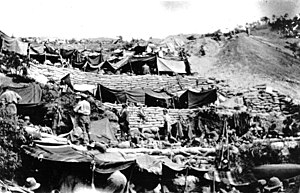Australian and New Zealand Army Corps (army corps)
| Australian and New Zealand Army Corps | |
|---|---|

New Zealand soldier's encampment at ANZAC Cove in 1915
|
|
| Active | 1914–16 |
| Countries | |
| Branch | Army |
| Type | Administrative Corps |
| Part of | Mediterranean Expeditionary Force |
| Nickname(s) | ANZAC |
| Anniversaries | Anzac Day |
| Engagements | First World War |
| Commanders | |
| Notable commanders |
William Birdwood |
The Australian and New Zealand Army Corps (ANZAC) was a First World War army corps of the Mediterranean Expeditionary Force. It was formed in Egypt in December 1914, and operated during the Battle of Gallipoli. General William Birdwood commanded the corps, which comprised troops from the First Australian Imperial Force and 1st New Zealand Expeditionary Force. The corps disbanded in 1916, following the Allied evacuation of the Gallipoli peninsula and the formation of I ANZAC Corps and II ANZAC Corps. The Corps was reestablished, briefly, in the Second World War during the Battle of Greece in 1941.
Plans for the formation began in November 1914 while the first contingent of Australian and New Zealand troops were still in convoy bound for, as they thought, Europe. However, following the experiences of the Canadian Expeditionary Force encamped on Salisbury Plain, it was decided not to subject the Australians and New Zealanders to the English winter and so they were diverted to Egypt for training before moving on to the Western Front in France. The British Secretary of State for War, Horatio Kitchener, appointed General William Birdwood, an officer of the British Indian Army, to the command of the corps and he furnished most of the corps staff from the Indian Army as well. Birdwood arrived in Cairo on 21 December 1914 to assume command of the corps.
...
Wikipedia
